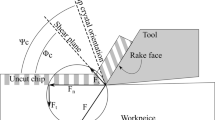Abstract
Mechanistic force models allow an estimation of the force components in cutting technology. This is essential for an accurate simulation of the force, an analysis of the tool load, or a model-based predictive force control. The model coefficients do not only depend on the material and the tool but also on the engagement condition. This requires an online identification of those coefficients. To determine those coefficients, this paper uses curve fitting based on the instantaneous uncut chip thickness, a method that has only recently gained momentum in milling. This work applies this technique to the well-established, nonlinear Kienzle force model. The paper reviews a broad range of nonlinear, derivative-free optimization algorithms for this least-squares curve-fitting problem evaluating accuracy and runtime. The evaluation is conducted on 121experiments with distinct process conditions resulting in a statistically verified conclusion. The results indicate that in spite of a heterogeneous optimization space, local constrained algorithms are most suited for model identification.
Similar content being viewed by others
References
Stemmler S, Abel D, Adams O, Klocke F (2016) 8th IFAC Conference on manufacturing modelling, management and control MIM 2016Troyes. France 49(12):11. https://doi.org/10.1016/j.ifacol.2016.07.542
Campatelli G, Scippa A (2012) . Procedia CIRP 1:563. https://doi.org/10.1016/j.procir.2012.04.100
Ehmann KF, Kapoor S, DeVor RE, Lazoglu I (1997) . J Manuf Sci Eng 119(4):655. https://doi.org/10.1115/1.2836805
Kienzle O (1952) In: VDI-Z. VDI, Verlag, vol 96, pp 299–305
Altintas Y, Lee P (1996) CIRP. Ann - Manuf Technol 45(1):59. https://doi.org/10.1016/S0007-8506(07)63017-0
Grossi N (2017) . Int J Precis Eng Manuf 18(8):1173. https://doi.org/10.1007/s12541-017-0137-x
Wan M, Zhang WH, Tan G, Qin GH (2007) . Proc Inst Mech Eng Part B: J Eng Manuf 221(6):1007. https://doi.org/10.1243/09544054JEM515
Wan M, Zhang WH, Dang JW, Yang Y (2009) . Int J Mach Tools Manuf 49(14):1144. https://doi.org/10.1016/j.ijmachtools.2009.08.005
Wei ZC, Guo ML, Wang MJ, Li SQ, Liu SX (2018) The international journal of advanced manufacturing technology. https://doi.org/10.1007/s00170-017-1380-0
Wang L, Si H, Guan L, Liu Z (2018) . Int J Adv Manuf Technol 94 (5):2961. https://doi.org/10.1007/s00170-017-1086-3
Wan M, Zhang WH (2009) . Int J Mach Tools Manuf 49(5):424. https://doi.org/10.1016/j.ijmachtools.2008.12.004
Auerbach T, Gierlings S, Veselovac D, Seidner R, Kamps S, Klocke F (2015) In: Proceedings of the ASME Turbo Expo: Turbine Technical Conference and Exposition 2015, ed. by A.S. of Mechanical Engineers. ASME, pp V006T21A006. https://doi.org/10.1115/GT2015-43209
Matsumura T, Tamura S (2017) . Proced CIRP 58:566. https://doi.org/10.1016/j.procir.2017.03.268
Wojciechowski S (2015) . Int J Mach Tools Manuf 89:110. https://doi.org/10.1016/j.ijmachtools.2014.10.006
Budak E, Altintas Y, Armarego EJA (1996) . J Manuf Sci Eng 118 (2):216. https://doi.org/10.1115/1.2831014
Karandikar JM, Schmitz TL, Abbas AE (2014) . J Manuf Sci Eng 136(2):021017. https://doi.org/10.1115/1.4026365
Adem KAM, Fales R, El-Gizawy AS (2015) . Int J Adv Manuf Technol 79 (9):1671. https://doi.org/10.1007/s00170-015-6935-3
Zhang D, Mo R, Chang Z, Sun H, Li C (2016) . Int J Adv Manuf Technol 84(1):621. https://doi.org/10.1007/s00170-015-7707-9
Yao Q, Luo M, Zhang D, Wu B (2018) . Mech Syst Signal Process 103:39. https://doi.org/10.1016/j.ymssp.2017.09.038
König W, Essel K, Witte L (1982) Verein Deutscher Eisenhüttenleute, Spezifische Schnittkraftwerte für die Zerspanung metallischer Werkstoffe. Verlag Stahleisen, Düsseldorf. OCLC: 64323901
Jayaram S, Kapoor S, DeVor R (2001) . Int J Mach Tools Manuf 41(2):265. https://doi.org/10.1016/S0890-6955(00)00076-6
Zhang Z, Li H, Meng G, Ren S, Zhou J (2017) . Int J Adv Manuf Technol 89(5):1709. https://doi.org/10.1007/s00170-016-9186-z
Kline W, DeVor R (1983) . Int J Mach Tool Des Res 23(2):123. https://doi.org/10.1016/0020-7357(83)90012-4
Nelder JA, Mead R (1965) . Comput J 7 (4):308. https://doi.org/10.1093/comjnl/7.4.308
Lagarias JC, Reeds JA, Wright MH, Wright PE (1998) . SIAM J Optim 9(1):112
Powell M (2004) The NEWUOA software for unconstrained optimization without derivatives. http://www.damtp.cam.ac.uk/user/na/NA_papers/NA2004_08.pdf.NA2004/08
Powell M (2009) The BOBYQA algorithm for bound constrained optimization without derivatives. http://www.damtp.cam.ac.uk/user/na/NA_papers/NA2009_06.pdf.DAMTP2009/NA06
Coleman TF, Li Y (1996) . SIAM J Optim 6(4):1040. https://doi.org/10.1137/S1052623494240456
Coleman TF, Li Y (1994) . Math Program 67(1):189. https://doi.org/10.1007/BF01582221
Rubeo MA, Schmitz TL (2016) . Precis Eng 45:311. https://doi.org/10.1016/j.precisioneng.2016.03.008
Rinnooy Kan AHG, Timmer GT (1987) . Math Program 39(1):27. https://doi.org/10.1007/BF02592070
Jones DR, Perttunen CD, Stuckman BE (1993) . J Optim Theory Appl 79 (1):157. https://doi.org/10.1007/BF00941892
Gablonsky JM, Kelley CT (2001) . J Glob Optim 21(1):27. https://doi.org/10.1023/A:1017930332101
Price WL (1983) . J Optim Theory Appl 40(3):333. https://doi.org/10.1007/BF00933504
Kaelo P, Ali MM (2006) . J Optim Theory Appl 130(2):253. https://doi.org/10.1007/s10957-006-9101-0
Dhupia J, Girsang I (2012) . Mach Sci Technol 16(2):287. https://doi.org/10.1080/10910344.2012.673978
Acknowledgements
The authors would like to thank the German Research Foundation (DFG) for the support of the depicted research within the Cluster of Excellence Integrative Production Technology for High-Wage Countries.
Furthermore, we would like to acknowledge the financial support of the Kopernikus-project “SynErgie”by the Federal Ministry of Education and Research (BMBF).
Selected preliminary results of this work were presented at the 14th International Conference on High Speed Machining 2018, San Sebastian, Spain.
Author information
Authors and Affiliations
Corresponding author
Additional information
Publisher’s Note
Springer Nature remains neutral with regard to jurisdictional claims in published maps and institutional affiliations.
Rights and permissions
About this article
Cite this article
Schwenzer, M., Auerbach, T., Döbbeler, B. et al. Comparative study on optimization algorithms for online identification of an instantaneous force model in milling. Int J Adv Manuf Technol 101, 2249–2257 (2019). https://doi.org/10.1007/s00170-018-3109-0
Received:
Accepted:
Published:
Issue Date:
DOI: https://doi.org/10.1007/s00170-018-3109-0



